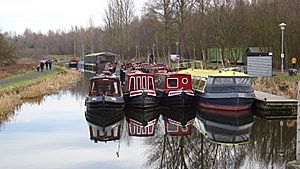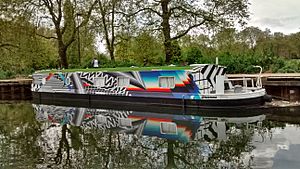Widebeam facts for kids

A widebeam is a type of canal boat. It looks a lot like a British narrowboat, but it's much wider. Widebeams are usually 2.16 metres (7 ft 1 in) or more across. You can find these boats on the waterways of the UK. The Canal & River Trust manages these canals and rivers.
Contents
What is a Widebeam Boat?
The Canal & River Trust doesn't have a super strict definition for a "widebeam." They just say it's different from other canal boats. These include narrowboats, Thames sailing barges, and Dutch barges. Modern widebeams have some key features that make them special.
How Widebeams are Built
A widebeam is built like a cruising narrowboat. This means it has a steel hull and is mostly used for fun trips. It usually has an open area at the front called a well-deck. Doors from here lead into the living space. The main room, called the saloon, often has many windows.
The roof of the boat might have solar panels or skylights. But the boat's total height must be low enough to fit under canal bridges. Just like narrowboats, a widebeam's back (or stern) can be a "cruiser" or "semi-trad" style. It's rare to see a widebeam with an old-fashioned "traditional" stern these days.
Most modern widebeams have their engine hidden under the back deck. You won't usually find an old-style engine room you can walk through.
Widebeam Shape and Steering
Narrowboats usually have a rectangular shape below the sides. But many widebeams have a special shape called a "chined" cross-section. This means the bottom of the boat isn't completely flat.
A chined hull helps the boat steer better. It stays on course more easily. This shape also lets the widebeam get closer to the canal bank. This is helpful when the canal is shallow or narrow.
History of Widebeam Boats
When canals were first built in England, locks were quite narrow. Most were only 2.1 metres (7 ft) wide. Soon, people realized it would be better to have wider canals. These wider canals would have wider locks, about 4.3 metres (14 ft) across.
Widebeam boats were then introduced to use these wider locks. This also meant that two narrowboats could fit side-by-side in a wide lock. This was useful if one boat was towing another, called a "butty" boat.
Today, a 17.4 metres (57 ft) long narrowboat can travel almost anywhere on the UK waterways. However, there isn't a wide canal link between the north and south of England. So, widebeams usually have to stay in one part of the country. They can't easily travel between north and south.
Most widebeams are not built for sea travel. They are "Class D vessels," meaning they are best for rivers, small lakes, and canals. Widebeams are more stable than narrowboats because they are wider. But their front well-deck can flood, so they are not true seagoing boats. There are plans to build a new canal link near Bedford. This would allow widebeams to move between the north and south. But this project might take many years to finish.
Widebeam Sizes and Rules

A widebeam boat must be 2.16 metres (7 ft 1 in) or wider. If a widebeam is used as a houseboat and stays in one place, it can be almost any size. But if a widebeam wants to travel the canals, it must fit certain size limits. These limits depend on the specific waterway.
A cruising widebeam's total length is limited by the shortest lock. Its width is limited by the narrowest lock or other tight spots. The boat's draft (how deep it sits in the water) is limited by the canal's depth. Canals are usually shallower near the sides. This can be a challenge for widebeams when they meet other boats. Also, a widebeam's height (called air draft) must be low enough to pass under bridges and through tunnels.
Size Limits Around London
If you want to cruise a widebeam in East London, for example, on the Lee Navigation, there are rules. From Hertford to Limehouse Basin, your boat can be up to 25.8 metres (84 ft 8 in) long. It can be 4.7 metres (15 ft 5 in) wide, 1.6 metres (5 ft 3 in) deep, and 2.18 metres (7 ft 2 in) high.
If you want to travel through central London on the Regent's Canal to Little Venice, the boat must be smaller. It can't be longer than 22.36 metres (73 ft 4 in). It must be no wider than 4.22 metres (13 ft 10 in) and no deeper than 1.28 metres (4 ft 2 in). A boat low enough for the Lee Navigation is also low enough for the Regents Canal.
The Paddington Arm of the Grand Union Canal has an even lower height limit. Boats here can only be 2.08 metres (6 ft 10 in) high.
If a boat turns south from the Paddington Arm and travels down the River Thames to Limehouse Basin, its maximum length is 22.2 metres (72 ft 10 in). If it turns north towards Rickmansworth, it can't be longer than 21.75 metres (71 ft 4 in).
Further north on the Grand Union Canal, near Leighton Buzzard, there's a lock only 3.81 metres (12 ft 6 in) wide. This means widebeams that are 4.22 metres (13 ft 10 in) wide (which can cruise in London) cannot go past this point.
To travel on the River Stort (a branch of the Lea), a widebeam needs to be even smaller. Its length, width, depth, and height must not be more than 21.75 metres (71 ft 4 in), 4.08 metres (13 ft 5 in), 1.03 metres (3 ft 5 in), and 2.05 metres (6 ft 9 in) respectively.



